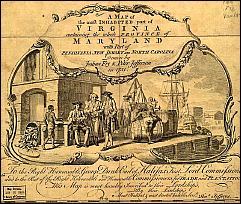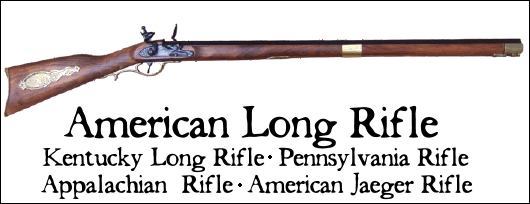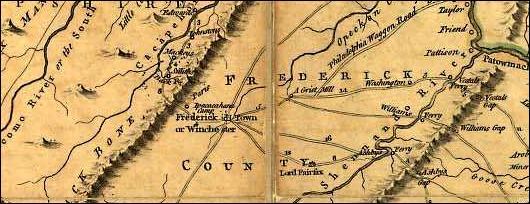Kentucky and Pennsylvania Long Rifle. A Piece of American History Forged in the Colonies, Used in the Alamo and at the Battle of New Orleans.

Before we look at the legendary "Kentucky Rifle", a little background may be in order. The name is a little misleading. Sure, these were certainly used in and around Kentucky during the 1700s and 1800s. But they were also known in Pennsylvania, Virginia, Tennessee, Maryland, North Carolina and any other region of colonial Appalachia, and worked their way Westward. While used in all these places, they were predominantly made in Pennsylvania. Not surprising when you consider that this is where a lot of the German immigrants settled with their Jaeger rifles, the basis of the Kentucky rifle. The name "Kentucky Rifle" came about in 1814 after some 2,000 frontiersmen/fighters from Kentucky, under General (later president) Andrew Jackson fought in the Battle of New Orleans, giving the British a run for their money, using the Jaeger-style long rifles they brought with them. After this, they came to be widely known as "Kentucky Rifles. The phenomenon didn't just materialize here, but was imported from the Old World. Even the mass-produced Brown Bess and Charleville muskets had their roots in the early Jaeger (pronounced Yay-Gur) hunting rifles of Prussia, a part of what is now Germany. This revolution from non-standard "wildcat" firearms to uniformity is an entire story in itself, and we'll not go into it here and now. So before we name a rifle after every state in the Eastern half of United States, it would also be accurate to think of them as "long rifles", which is also an accurate term. At the time, smoothbore muskets were the common military technology, and rifles were used mostly for hunting. The earliest Jaeger rifles originated in the states that would later be known as Germany, in the late 1600s and early 1700s. Used mainly by hunters, (Jaeger is German for "hunter") they were first introduced into limited military service in the 1756 "Seven Years War" in Europe under Frederick the Great. This was also the time that immigrant settlers in colonial America (especially the German settlers who had set up shop in Pennsylvania) were making long rifles by hand. The Kentucky/Pennsylvania rifle is essentially the American version of a Jaeger rifle, although from that point onward, they developed according to Appalachian culture, and were lengthened to accommodate better burning of the powder for more velocity.
At this time, very few people had yet seized upon the concept of using rifles for combat. They primarily used muskets, usually with bayonets. However, hunting with rifles was--and still is--alive and well. Firearms had just recently replaced hand-to-hand fighting with swords and sabres as a major combat technique, but not entirely. The bayonet was a throwback to the use of swords, pikes and other polearms, and remarkably, didn't disappear entirely until around World War II. In colonial times, mainstream combat did not utilize the concept of taking careful aim, but of marching toward the enemy, and laying down a devastating volley of musket fire. Of course this was not practical for hunting game. Rifles also took longer to load than muskets, another reason that they weren't used for combat. Hunting for game is where the rifles come in. "Rifle" meant that there were grooves cut into the bore (inside of the barrel) to give the projectile a spin, for greater stability, accuracy and distance, something that is vitally important if you rely on hunting game for your subsistence. Obviously at this time, all rifles and muskets used the flintlock firing system, or a similar device and were muzzle loaders. The Germans had laid the groundwork for the future of firearms, and the rifle would eventually completely overtake the musket as a military weapon, but not until over a hundred years later. There were, however, those American colonials who made use of these Kentucky/Pennsylvania rifles for combat against the British in the American War for independence. Rather than lining up in rows as in traditional military combat, they would hide out behind rocks and trees and take careful aim, sniper-style. The surprised British officers found this to abhorrent and dishonorable, but also very deadly to them. Soon, stories were being told in England about the colonist's deadly accurate and sneaky "long rifles." Today, snipers are the precision arm of all major military forces. Even though these tactics by the Americans helped to win them the war, the rife was not adapted for mainstream combat until late in the American Civil War.
It helps to understand that a lot of the development of the Kentucky Rifle (or whatever name you prefer) was aided--like in modern times--by traffic. Many settlers, especially Scottish, Irish, Dutch and Germans, settled areas of central Pennsylvania along what was then known as the Great Wagon Road. A travel way that ran from Philadelphia--the capitol of the colonies--to North Carolina. There was also a continuation of this road from North Carolina to Georgia, though it was generally not passable for wagons. If you've been acquainted with that region, as I have, i t would very roughly include what is now US 30 between Philadelphia, running through Lancaster and York, branching out into Interstates I-81, I-70, I-68 and I-40. The Great Wagon Road was a major source of commerce, helped build up the colonies, as well as giving rise to the Kentucky/Pennsylvania Long Rifles, and also is geographically aligned with the cultural and technological development of these rifles. This road was probably not much fun to travel on in those days. Winding over the steep Appalachian Mountains, following rivers, frequently flooded or frozen, across rivers and streams, without the benefit of pavement. It's not much fun to drive it even today, although it's vastly improved since then, and much easier and safer. Driving fro m Mechanicsburg, Pennsylvania south on I-81 down into Virginia onto I-77 into Statesville, North Carolina, then on I-40 to Winston-Salem would give you a very rough idea of the terrain. It's very steep and hilly there.The commerce is still there, although much more developed. It's interesting to consider your history, and why things are the way they are. Too many people seem inclined to take the present for granted, as if history spontaneously started with themselves, and don't pause to consider the long march of events that placed them there. If not for the blacksmiths, farriers, stables, gunsmiths, inns and taverns along the Great Wagon Road in the 1750s, do you really think you'd be able to stay in a Motel 6 on Interstate 81 and have dinner at Red Lobster? It's not a mistake that the old German art of making Jaeger Rifles ended up being the basis for the Kentucky/Pennsylvania Rifle, which originated from these areas. The Great Wagon Road helped make them the American classics that they are today.

While small arms were a technological development that evolved from cannon in post-renaissance Europe, there is not good, solid documentation from that far back, but rather individual accounts of a weapon here and there. Firearms evolved much like societies do. Starting out isolated, disorganized and undocumented, and progressing into an ordered and organized system. This was the case for the Jaeger rifles. They began to appear on the scene and became more common, and that path of development eventually led us all the way to the high-tech integrated-laser wonderguns being produced today.
While firearms are produced elsewhere, and while gunpowder is an ancient Chinese invention, almost all firearms technology and production is either from Europe or North America. This is still evident in the proliferation of firearms producers in the United States, UK, Germany, Russia, France, Belgium, Italy and some other European nations. All of the well-known small arms manufacturers are located either in North America or Europe, even today.
Though a modern Winchester lever-action 30-30, based on the vastly successful model 1894, makes for a fine hunting rifle, it is the artistic craftsmanship and often one-of-a-kind uniqueness that really sets the old Kentucky rifles apart. It was common for long rifles to be artfully engraved and gilded. And they were a vital and necessary tool for survival, being used for both hunting game, (food) and self defense. The long rifles saw some military use against various Indians and the British in the revolution since many fighting units were comprised of volunteers who showed up, each with their own long rifles, set in their own caliber. This "wildcat" approach to freelance arms was a common practice, that continued for over a hundred years. David "Davy" Crockett wasn't the only person who showed up at the Alamo with a "Kentucky" rifle. Unlike modern firearms, many of which are fine products, the old long rifles were known to have some fine, personal touches. Kentucky/Pennsylvaia rifles had finely engraved scrollwork, especially on patchboxes--an innovation that was developed among gunsmiths in America--especially in the Appalachian Mountains, with carved and polished wood, inlaid precious metals such as gold and silver, hand-blued barrels, and more.

Unlike other guns that I write about, both classical and contemporary, it's more difficult to come up with exact, consistent information about the old Kentucky long rifles, because there isn't any. Unlike contemporary firearms, they were not mass-produced to a standard design, but rather were hand-made by individual craftsmen, the skills and the arts started in the German lands, brought over here by immigrants and passed down through generations. For a very long time, this fine art was in decline, giving way to mass-produced firearms, leaving behind only rural, isolated pockets of Long Rifle artisans. The art never died out altogether, but came close in the 1950s. Happily, in the last 60 years, there has been a revival of interest in the fine art of gunsmithing and engraving. Once again, there are craftsmen producing works of art in the form of long Kentucky rifles that use black powder--an authentic hobby with a growing fan base. They are popular not only with collectors, but with living history actors, sometimes called reenactors. To have a hand-made long rifle, complete with artistic scrollwork engraving is not cheap, nor are the other items used by re-enactors, such as uniforms or other period dress and all of the myriad accessories. This shows that they are obviously devoted to the hobby or lifestyle, since they are wiling to go to so much trouble and expense for the sake of historical accuracy. Reenactors often employ the actual military discipline and hierarchy of the real war, itself. The further back in history you go, the more difficult it is to recreate the feel of the period.
The Kentucky rifle gave rise to a new culture of "mountain men". These rugged individualists not only hunted and trapped game for the purpose of getting food, but to collect animal hides, fur and leather--which had become fashionable in London--to sell. They would deploy themselves to the mountain wilderness, usually operating solo, collecting furs and pelts, and occasionally meet up at a rendezvous. This was a large gathering to buy, sell, trade, feast and get drunk, and to catch up with old friends. This went on until well into the 1800s, when industrialization began to overtake the rural nature of mountain man culture and commerce. As America expanded Westward, the mountain man culture lead to the development of a shorter, lighter rifle, with thicker barrels and larger calibers, to facilitate shooting larger game. These came to be known as the "Plains Rifle" or or were referred to as carbines. This eventually led to the manufacture of the Hawken rifle, which became common among mountain men moving westward towards the Rocky Mountains in the fur trade. Of course, they all still owe their heritage to the Kentucky Rifles of Pennsylvania.
Firearm Type:
Flintlock Jaeger or Flintlock Long Kentucky Rifle
Nation Of Origin: Prussia, American
Colonies of Britain, United States
Military Service: 1756-1836 (Hunting
Rifle-No official start or stop date)
Variations: Jaeger, Long Rifle, Kentucky
Rifle, Plains, more.
Ammunition: Various Calibers of Hand-Made
lead balls
Wars: 7 Years War, American War of
Independence, War of 1812, Alamo, more.
Recent Prices at Auction for Originals: US
$2,000 to $10,000
Interested in an authentic
replica Kentucky Rifle / Pennsylvania Long Rifle ?